The 50 works on display in the Japanese-Swiss artist Leiko Ikemura’s first exhibition in the UK –‘Usagi in Wonderland’ – invite us to tumble down the proverbial rabbit hole. Here you will find three decades of artistic practice: from paintings produced in the early ’90s to glass sculptures created during lockdown. The media Ikemura employs include photographs, video, bronze and terracotta. Despite what this may imply, the exhibition is strikingly unified, with the pieces working in tandem to conjure a fantastical world in which spectral girls sprout animal ears and grow tentacles, human heads germinate forests, limbs morph into vegetal and animal forms, and mountains and lakes resolve themselves into faces and reclining bodies. Ikemura (who is also a poet) has explained that in Japanese the word usagi means ‘rabbits’ and ‘hares’, but also suggests a more talismanic being who, like Alice’s rabbit, has the capacity to – as Ikemura writes – ‘spring from border to border/And break the established linear system’. Channelling usagi both literally and figuratively, this show demonstrates how Ikemura’s own oeuvre erodes boundaries – gesturing at a shift away from a world-view defined by dualism and logic, towards something irrational, mysterious and poetic.
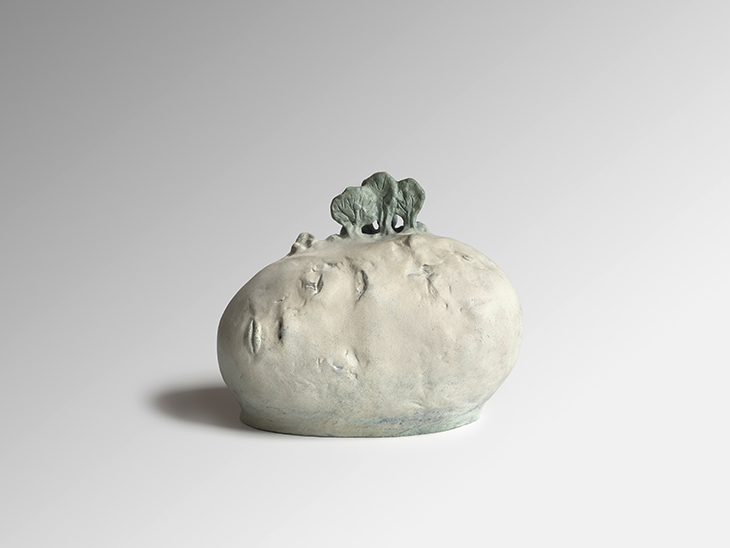
Trees out of Head (2015/20), Leiko Ikemura
Because of pandemic-related delays, the exhibition has been reduced to half its original size and relocated from the Sainsbury Centre’s gallery floor to a separate mezzanine. The move foregrounds Norman Foster’s architecture in a display that was curated and designed by Ikemura with input from her partner, the architect Philipp von Matt. They have divided a single, open room into three major areas, using panel walls to guide visitors through the space that clearly delineates the work while creating a sense of flow and unity. With open views across the gallery and over the tree-ringed sculpture park, there is also a sense of harmony between the art and an architecture that Ikemura has describes as a ‘kind of “between” space […] [where] you ‘have direct contact with nature’.
In the first space, a series of ‘Girls’ canvases features painted figures that have indistinct faces and bodies, like mounds of partially sculpted clay. They are distant and dreamlike, as if refracted through water, and they lack obviously girlish features. Somehow, though, you can tell that they are girls: the blocks of candy-bright colours, perhaps, or their large eyes and child-sized bodies. Here, Ikemura plays on stereotypes of ‘cuteness’ and purity, but when you look closer, you’ll see the darkness of violence, or self-destruction, masked beneath the bubblegum colour: some plug their mouths, others attempt to rub out their own eyes. Ikemura has spoken of the sensory organs as ‘wounds’ that ‘connect the self with the external world’. In these gestures, where the girls seek to violate or mutilate themselves, Ikemura draws attention to the often self-annihilating, always-lonely experience of our teenage years, and to the filament-thin membrane that separates seeing from suffering.
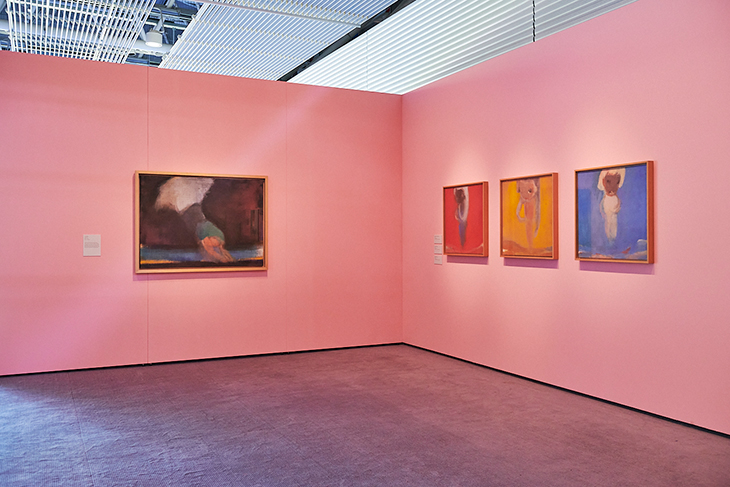
Installation view of ‘Usagi in Wonderland’ at the Sainsbury Centre, with canvases from 1996–99. Photo: Andi Sapey; courtesy the Sainsbury Centre
A different duality exists in Memento Mori (2013/18), a torso-sized sculpture in patinated bronze. The Western tradition of memento mori is recalled in a figure of a skeletal girl with frail limbs and sunken eyes, lying on her side against a video installation that makes her appear to float on water. Her surface is a uniform white, and against it shadows appear as striking as scars. The contrast is clearest in the area of the girl’s temple where, in lieu of an ear, a borehole opens against the arc of her skull. Dark shadows are also visible in the strange, gill-like cuts that run down her breast and abdomen and in the crack that bursts the upper seam of her hip; a crack that leads not to legs but to a curved shape that most closely resembles a ripening seed-pod. The figure we see is petite and defenceless, but the durability of the bronze – its toughness – undermines this impression, as if the fragility and even the bone-like colourisation are only skin-deep. What seems more important than the impression of vulnerability is the life that stimulates two tiny ears to grow from her crown, and to germinate whatever is growing in her abdomen. The membrane here is between death and life, nothingness and vitality.
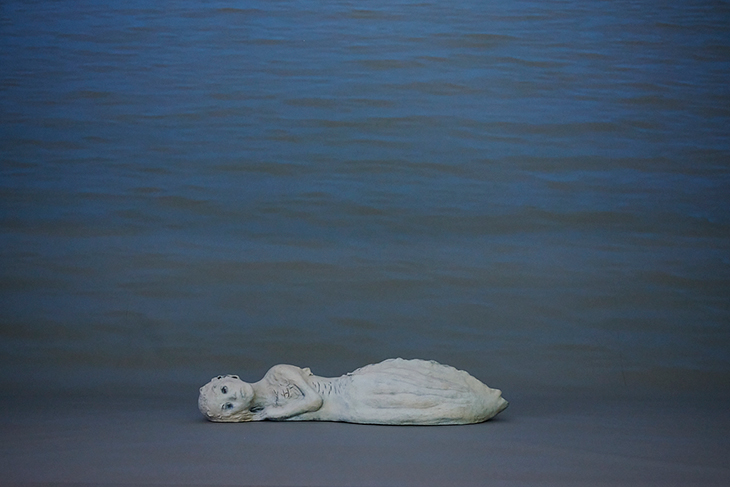
Memento Mori (2013/18), Leiko Ikemura
Cavities and holes also serve a more mundane purpose: to draw attention to the materiality of these objects. This is particularly clear in the terracotta figures that Ikemura presents with a deliberately naive finish: unfolded edges, rough modelling, scratched surfaces, and hastily applied glazes. There is something fiercely humane in the tactility of pieces like White Figure with Blue Miko (1996) – a headless girl cradling a small cat in her arms. In this and other sculptures, the obviousness of Ikemura’s craftsmanship, their declarations of imperfection, are what allow her to produce art that, despite its reach for transcendence, is approachable and appealing.
All of Ikemura’s figures seem to exist close to the edges – in some cases literally, as in Sinus Spring (2018), a large triptych that sings off the wall in washes of acid red, tangerine, peacock and mustard. Ghostly female forms float through a sinuous landscape, visually echoing them with both their colours and their fluid shapes. Their bodies lack definitions and boundaries and occupy a liminal space that is part physiognomy, part geology; part presence, part absence.

Sinus Spring (detail; 2018), Leiko Ikemura. Photo: Jörg von Bruchhausen; © Leiko Ikemura and VG Bild-Kunst 2021
Critics tend to describe Ikemura, who has lived in Japan, Switzerland, Spain and Germany, as an artist who offers a cross-cultural, global language, but the artist pitches it as one that explores ‘the connectivity of all aspects of nature’. As a concept, ‘connectivity’ will soon be underscored by the installation of her bronze Usagi Kannon (Rabbit Bodhisattva of Mercy) – a three-metre bronze skirted rabbit – in the sculpture park. This final usagi, made in response to the Tōhoku earthquake and Fukushima nuclear disaster in 2011, provides a shelter for visitors under its tent-like skirt. To enter is to cross a threshold into Ikemura’s Wonderland: a space that anchors the mysterious to the real, that is both of this world and not.
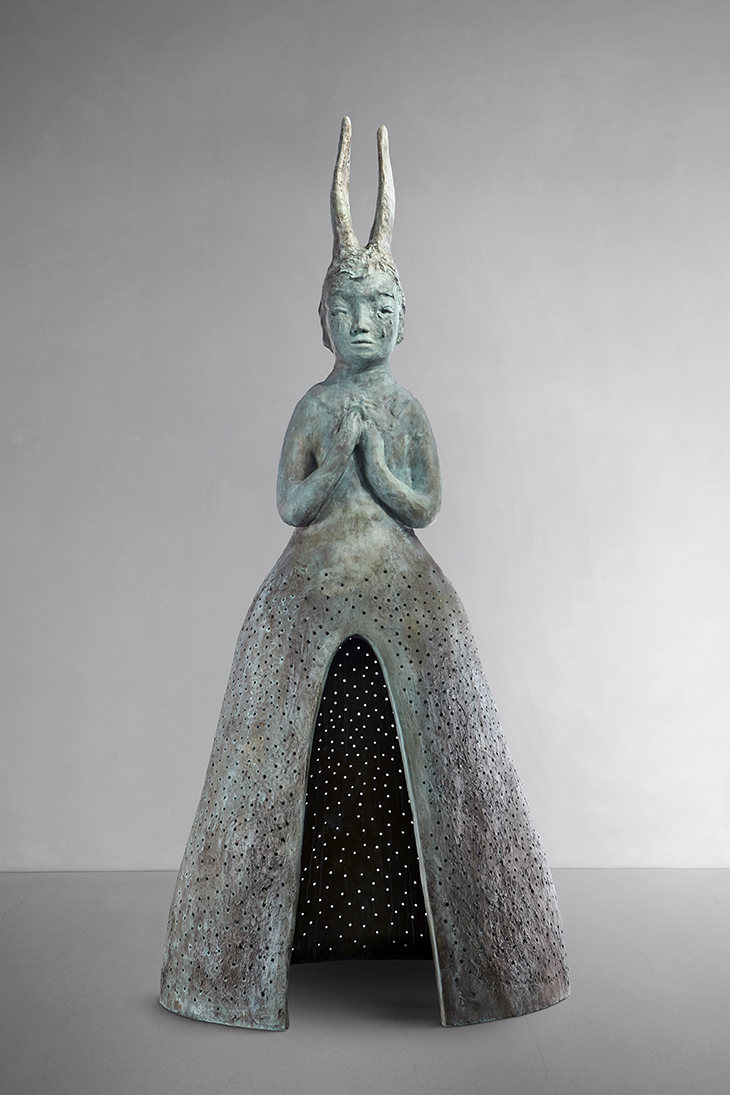
Usagi Kannon (2012/19), Leiko Ikemura. Photo: Andreas Lange; © Leiko Ikemura and VG Bild-Kunst 2021
‘Leiko Ikemura: Usagi in Wonderland’ is at the Sainsbury Centre, Norwich, until 12 December.
Unlimited access from just $16 every 3 months
Subscribe to get unlimited and exclusive access to the top art stories, interviews and exhibition reviews.



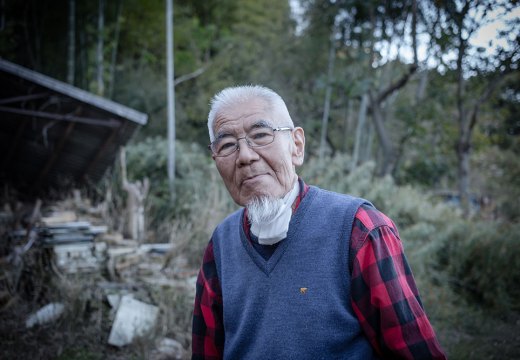
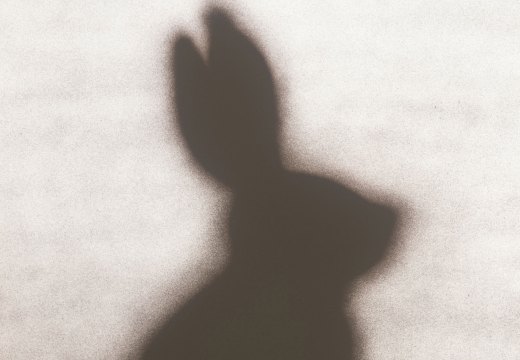









![Masterpiece [Re]discovery 2022. Photo: Ben Fisher Photography, courtesy of Masterpiece London](http://www.apollo-magazine.com/wp-content/uploads/2022/07/MPL2022_4263.jpg)
It’s time for the government of London to return to its rightful home